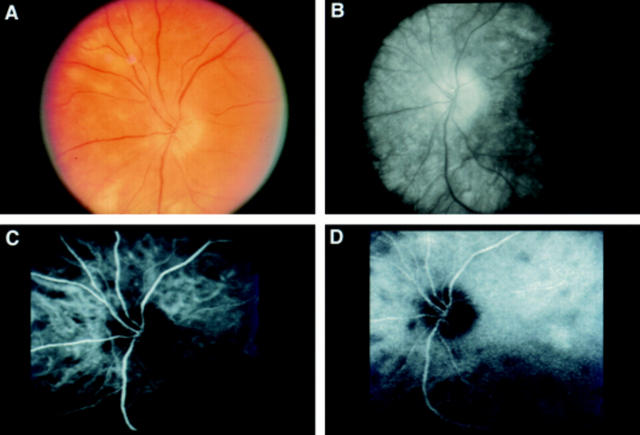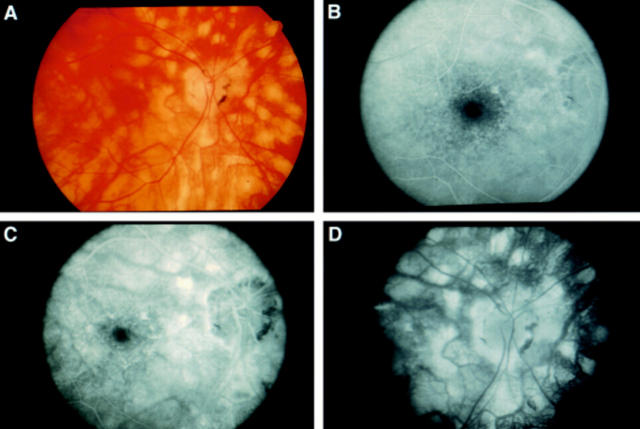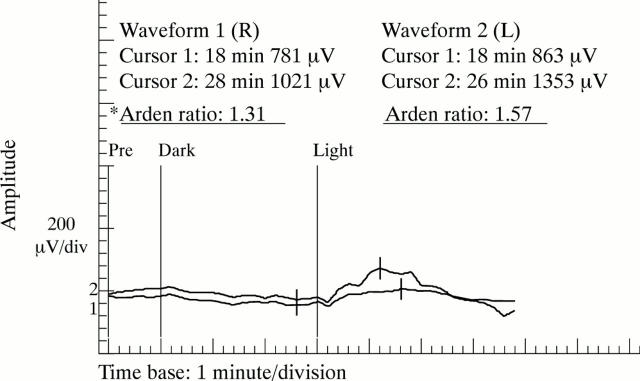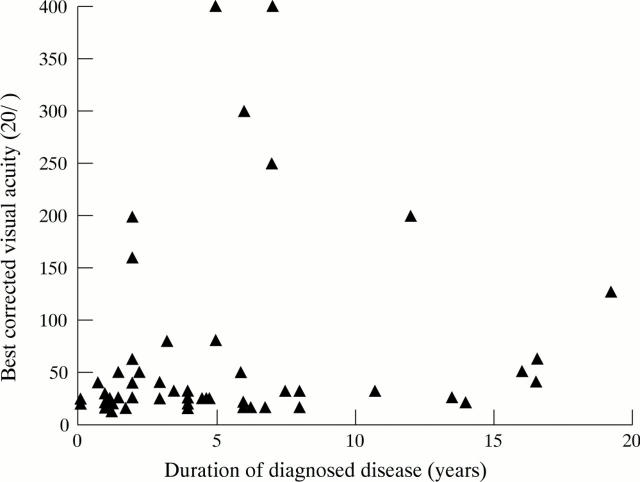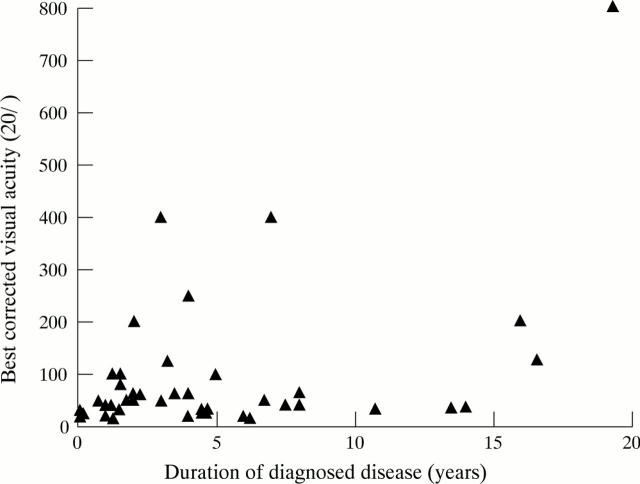Full Text
The Full Text of this article is available as a PDF (202.0 KB).
Figure 1 .
(A) Photograph of the left peripapillary fundus of a patient with short standing birdshot retinochoroidopathy, showing relatively few birdshot lesions and optic disc oedema. (B) Late phase of fluorescein angiography of the same eye, demonstrating silence of birdshot lesions. Optic disc leakage also is evident. (C) and (D) Early and late phases respectively of indocyanine green angiography of the same eye, revealing more birdshot lesions than ophthalmoscopy or fluorescein angiography. The lesions manifest early in the study and persist essentially unchanged. There is no sign of the optic disc oedema evident with fluorescein angiography.
Figure 2 .
(A) Photograph of the right posterior pole of a patient with long standing birdshot retinochoroidopathy, showing diffuse birdshot lesions and circumpapillary retinal atrophy. (B), (C), and (D) Early, mid, and late phases respectively of fluorescein angiography of the same eye, demonstrating staining of birdshot lesions.
Figure 3 .
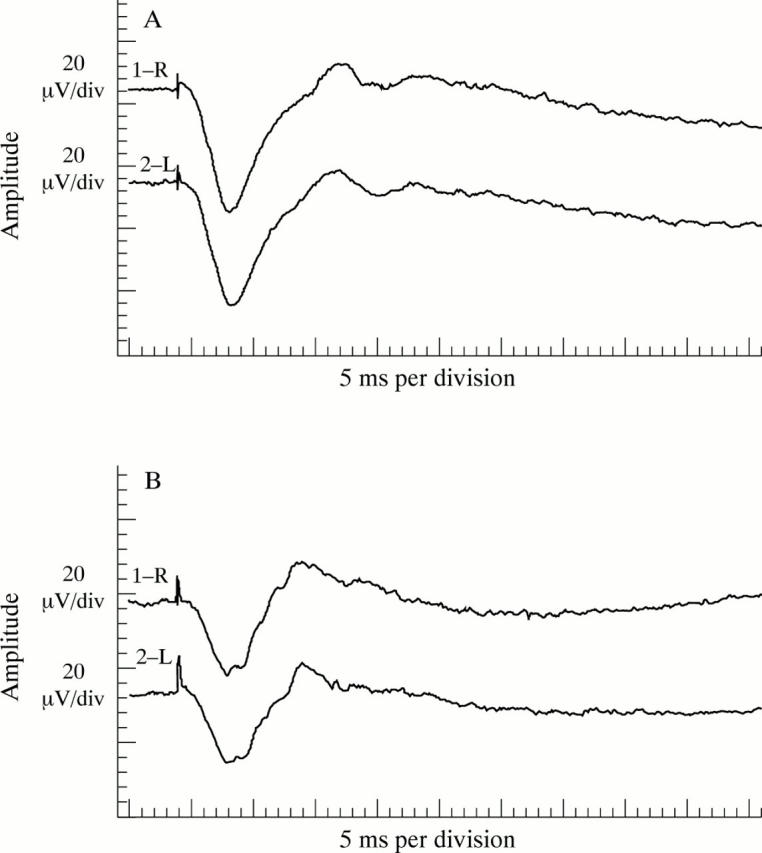
Electroretinogram maximal retinal responses of two patients with birdshot retinochoroidopathy. (A) A normal a-wave amplitude and moderately reduced b-wave amplitude, resulting in an abnormally low b- to a-wave ratio, suggests more compromise of intermediate than outer retinal layers. (B) Equally reduced a- and b-wave amplitudes, resulting in a normal b- to a-wave ratio, suggests photoreceptor involvement.
Figure 4 .
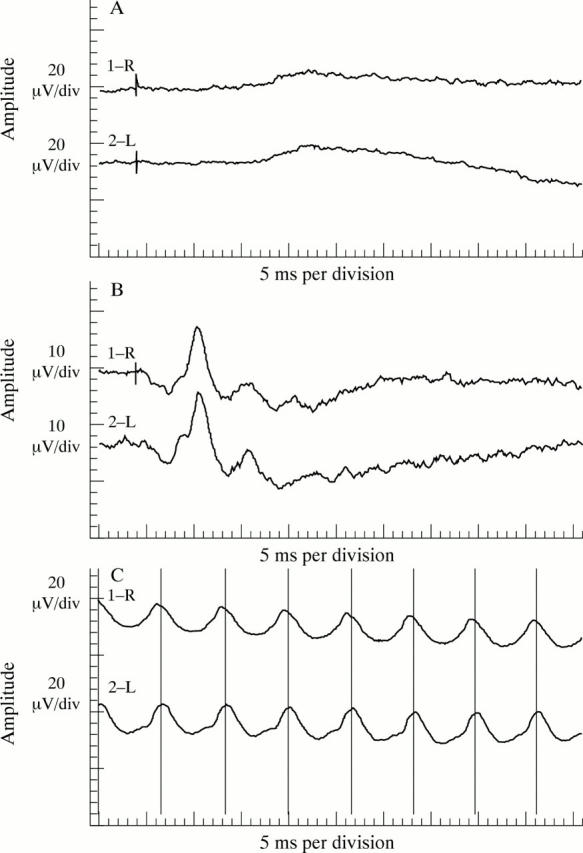
Electroretinogram rod mediated, cone mediated, and flicker responses of the patient whose maximal retinal response is shown in Figure 3B. (A) Rod mediated responses have a reduced amplitude. (B) Cone mediated responses have a less reduced amplitude. (C) Flicker responses, which cones generate, have a reduction in amplitude equal to that of the cone mediated responses.
Figure 5 .
Electro-oculogram of a patient with birdshot retinochoroidopathy. Dark trough and light peak amplitudes and light peak implicit times are within the normal range for both eyes. The Arden ratio is below the normal range for the right eye and at the low end of the normal range for the left eye. *Normal Arden ratio: mean 2.51 (SD 0.48); range 1.56-3.46.
Figure 6 .
Best corrected visual acuity of the better sighted eye versus duration of diagnosed disease for the NEI birdshot population, except for one eye with finger counting vision and three patients (six eyes) whose duration of diagnosed disease was unavailable (n=55).
Figure 7 .
Best corrected visual acuity of the worse sighted eye versus duration of diagnosed disease for the NEI birdshot population, except for five eyes with finger counting vision, two eyes with hand movement vision, two eyes that had been enucleated due to sequelae of cataract extraction, and three patients (six eyes) whose duration of diagnosed disease was unavailable (n=45).
Selected References
These references are in PubMed. This may not be the complete list of references from this article.
- Abrams J., Schlaegel T. F., Jr The role of the isoniazid therapeutic test in tuberculous uveitis. Am J Ophthalmol. 1982 Oct;94(4):511–515. doi: 10.1016/0002-9394(82)90245-8. [DOI] [PubMed] [Google Scholar]
- Amalric P., Cuq G. Une forme très particulière de choriorétinopathie en grains de riz. Bull Soc Ophtalmol Fr. 1981 Jan;81(1):131–134. [PubMed] [Google Scholar]
- Baarsma G. S., Kijlstra A., Oosterhuis J. A., Kruit P. J., Rothova A. Association of birdshot retinochoroidopathy and HLA-A29 antigen. Doc Ophthalmol. 1986 Jan 15;61(3-4):267–269. doi: 10.1007/BF00142352. [DOI] [PubMed] [Google Scholar]
- Baarsma G. S., Priem H. A., Kijlstra A. Association of birdshot retinochoroidopathy and HLA-A29 antigen. Curr Eye Res. 1990;9 (Suppl):63–68. doi: 10.3109/02713689008999422. [DOI] [PubMed] [Google Scholar]
- Barondes M. J., Fastenberg D. M., Schwartz P. L., Rosen D. A. Peripheral retinal neovascularization in birdshot retinochoroidopathy. Ann Ophthalmol. 1989 Aug;21(8):306–308. [PubMed] [Google Scholar]
- Brod R. D. Presumed sarcoid choroidopathy mimicking birdshot retinochoroidopathy. Am J Ophthalmol. 1990 Mar 15;109(3):357–358. doi: 10.1016/s0002-9394(14)74573-8. [DOI] [PubMed] [Google Scholar]
- Brucker A. J., Deglin E. A., Bene C., Hoffman M. E. Subretinal choroidal neovascularization in birdshot retinochoroidopathy. Am J Ophthalmol. 1985 Jan 15;99(1):40–44. doi: 10.1016/s0002-9394(14)75864-7. [DOI] [PubMed] [Google Scholar]
- Caballero-Presencia A., Diaz-Guia E., Lopez-Lopez J. M. Acute anterior ischemic optic neuropathy in birdshot retinochoroidopathy. Ophthalmologica. 1988;196(2):87–91. doi: 10.1159/000309881. [DOI] [PubMed] [Google Scholar]
- Dannenberg A. L., Garrison R. J., Kannel W. B. Incidence of hypertension in the Framingham Study. Am J Public Health. 1988 Jun;78(6):676–679. doi: 10.2105/ajph.78.6.676. [DOI] [PMC free article] [PubMed] [Google Scholar]
- FRANCESCHETTI A., BABEL J. La choriorétinite en taches de bougie, manifestation de la maladie de Besnier-Boeck. Ophthalmologica. 1949 Oct-Nov;118(4-5):701–710. doi: 10.1159/000300769. [DOI] [PubMed] [Google Scholar]
- Faure J. P. Autoimmunity and the retina. Curr Top Eye Res. 1980;2:215–302. [PubMed] [Google Scholar]
- Faure J. P., Phuc L. H., Takano S., Sterkers M., Thillaye B., de Kozak Y. Uvéo-rétinite expérimentale induite par l'antigène S rétinien chez le singe. Induction, histopathologie. J Fr Ophtalmol. 1981;4(6-7):465–472. [PubMed] [Google Scholar]
- Feltkamp T. E. Ophthalmological significance of HLA associated uveitis. Eye (Lond) 1990;4(Pt 6):839–844. doi: 10.1038/eye.1990.133. [DOI] [PubMed] [Google Scholar]
- Fich M., Rosenberg T. Birdshot retinochoroidopathy in monozygotic twins. Acta Ophthalmol (Copenh) 1992 Oct;70(5):693–697. doi: 10.1111/j.1755-3768.1992.tb02155.x. [DOI] [PubMed] [Google Scholar]
- Fuerst D. J., Tessler H. H., Fishman G. A., Yokoyama M. M., Wyhinny G. J., Vygantas C. M. Birdshot retinochoroidopathy. Arch Ophthalmol. 1984 Feb;102(2):214–219. doi: 10.1001/archopht.1984.01040030164018. [DOI] [PubMed] [Google Scholar]
- Gass J. D. Acute posterior multifocal placoid pigment epitheliopathy. Arch Ophthalmol. 1968 Aug;80(2):177–185. doi: 10.1001/archopht.1968.00980050179005. [DOI] [PubMed] [Google Scholar]
- Gass J. D. Vitiliginous chorioretinitis. Arch Ophthalmol. 1981 Oct;99(10):1778–1787. doi: 10.1001/archopht.1981.03930020652006. [DOI] [PubMed] [Google Scholar]
- Guex-Crosier Y., Pittet N., Herbort C. P. Evaluation of laser flare-cell photometry in the appraisal and management of intraocular inflammation in uveitis. Ophthalmology. 1994 Apr;101(4):728–735. doi: 10.1016/s0161-6420(13)31050-1. [DOI] [PubMed] [Google Scholar]
- Heaton J. M., Mills R. P. Sensorineural hearing loss associated with birdshot retinochoroidopathy. Arch Otolaryngol Head Neck Surg. 1993 Jun;119(6):680–681. doi: 10.1001/archotol.1993.01880180100019. [DOI] [PubMed] [Google Scholar]
- Henderly D. E., Genstler A. J., Smith R. E., Rao N. A. Changing patterns of uveitis. Am J Ophthalmol. 1987 Feb 15;103(2):131–136. doi: 10.1016/s0002-9394(14)74217-5. [DOI] [PubMed] [Google Scholar]
- Henkind P. Ocular neovascularization. The Krill memorial lecture. Am J Ophthalmol. 1978 Mar;85(3):287–301. [PubMed] [Google Scholar]
- Hesse S., Berbis P., Chemila J. F., Privat Y. Psoriasis and birdshot chorioretinopathy: response to aromatic retinoids. Dermatology. 1993;187(2):137–139. doi: 10.1159/000247225. [DOI] [PubMed] [Google Scholar]
- Hirose T., Katsumi O., Pruett R. C., Sakaue H., Mehta M. Retinal function in birdshot retinochoroidopathy. Acta Ophthalmol (Copenh) 1991 Jun;69(3):327–337. doi: 10.1111/j.1755-3768.1991.tb04823.x. [DOI] [PubMed] [Google Scholar]
- Hofmann H. M., Feicht B. Birdshot-Retinochorioideopathie: Systemische Therapie mit Corticosteroiden und nichtsteroidalen Antiphlogistika. Klin Monbl Augenheilkd. 1990 Aug;197(2):159–161. doi: 10.1055/s-2008-1046261. [DOI] [PubMed] [Google Scholar]
- Jampol L. M., Sieving P. A., Pugh D., Fishman G. A., Gilbert H. Multiple evanescent white dot syndrome. I. Clinical findings. Arch Ophthalmol. 1984 May;102(5):671–674. doi: 10.1001/archopht.1984.01040030527008. [DOI] [PubMed] [Google Scholar]
- Kalsow C. M., Wacker W. B. Pineal reactivity of anti-retina sera. Invest Ophthalmol Vis Sci. 1977 Feb;16(2):181–184. [PubMed] [Google Scholar]
- Kaplan H. J., Aaberg T. M. Birdshot retinochoroidopathy. Am J Ophthalmol. 1980 Dec;90(6):773–782. doi: 10.1016/s0002-9394(14)75192-x. [DOI] [PubMed] [Google Scholar]
- Laroche L., Saraux H., Quentel G., Le Hoang P. Bird-shot chorioretinopathy après décollement de rétine: origine auto-immune probable. Bull Soc Ophtalmol Fr. 1983 Nov;83(11):1245–1247. [PubMed] [Google Scholar]
- Le Hoang P., Girard B., Deray G., Le Minh H., De Kozak Y., Thillaye B., Faure J. P., Rousselie F. Cyclosporine in the treatment of birdshot retinochoroidopathy. Transplant Proc. 1988 Jun;20(3 Suppl 4):128–130. [PubMed] [Google Scholar]
- LeHoang P., Ozdemir N., Benhamou A., Tabary T., Edelson C., Betuel H., Semiglia R., Cohen J. H. HLA-A29.2 subtype associated with birdshot retinochoroidopathy. Am J Ophthalmol. 1992 Jan 15;113(1):33–35. doi: 10.1016/s0002-9394(14)75749-6. [DOI] [PubMed] [Google Scholar]
- Nordmann J. P., De Kozak Y., Le Hoang P., Faure J. P. Cyclosporine therapy of guinea-pig autoimmune uveoretinitis induced with autologous retina. J Ocul Pharmacol. 1986 Fall;2(4):325–333. doi: 10.1089/jop.1986.2.325. [DOI] [PubMed] [Google Scholar]
- Nozik R. A., Dorsch W. A new chorioretinopathy associated with anterior uveitis. Am J Ophthalmol. 1973 Nov;76(5):758–762. doi: 10.1016/0002-9394(73)90573-4. [DOI] [PubMed] [Google Scholar]
- Nussenblatt R. B., Kuwabara T., de Monasterio F. M., Wacker W. B. S-antigen uveitis in primates. A new model for human disease. Arch Ophthalmol. 1981 Jun;99(6):1090–1092. doi: 10.1001/archopht.1981.03930011090021. [DOI] [PubMed] [Google Scholar]
- Nussenblatt R. B., Mittal K. K., Ryan S., Green W. R., Maumenee A. E. Birdshot retinochoroidopathy associated with HLA-A29 antigen and immune responsiveness to retinal S-antigen. Am J Ophthalmol. 1982 Aug;94(2):147–158. doi: 10.1016/0002-9394(82)90069-1. [DOI] [PubMed] [Google Scholar]
- Nussenblatt R. B., Palestine A. G., Chan C. C. Cyclosporin A therapy in the treatment of intraocular inflammatory disease resistant to systemic corticosteroids and cytotoxic agents. Am J Ophthalmol. 1983 Sep;96(3):275–282. doi: 10.1016/s0002-9394(14)77814-6. [DOI] [PubMed] [Google Scholar]
- Priem H. A., De Rouck A., De Laey J. J., Bird A. C. Electrophysiologic studies in birdshot chorioretinopathy. Am J Ophthalmol. 1988 Oct 15;106(4):430–436. doi: 10.1016/0002-9394(88)90879-3. [DOI] [PubMed] [Google Scholar]
- Priem H. A., Kijlstra A., Noens L., Baarsma G. S., De Laey J. J., Oosterhuis J. A. HLA typing in birdshot chorioretinopathy. Am J Ophthalmol. 1988 Feb 15;105(2):182–185. doi: 10.1016/0002-9394(88)90183-3. [DOI] [PubMed] [Google Scholar]
- Priem H. A., Oosterhuis J. A. Birdshot chorioretinopathy: clinical characteristics and evolution. Br J Ophthalmol. 1988 Sep;72(9):646–659. doi: 10.1136/bjo.72.9.646. [DOI] [PMC free article] [PubMed] [Google Scholar]
- Ryan S. J., Maumenee A. E. Birdshot retinochoroidopathy. Am J Ophthalmol. 1980 Jan;89(1):31–45. doi: 10.1016/0002-9394(80)90226-3. [DOI] [PubMed] [Google Scholar]
- Schlaegel T. F., Jr, Kao S. F. A review (1970-1980) of 28 presumptive cases of syphilitic uveitis. Am J Ophthalmol. 1982 Apr;93(4):412–414. doi: 10.1016/0002-9394(82)90129-5. [DOI] [PubMed] [Google Scholar]
- Soubrane G., Bokobza R., Coscas G. Late developing lesions in birdshot retinochoroidopathy. Am J Ophthalmol. 1990 Feb 15;109(2):204–210. doi: 10.1016/s0002-9394(14)75988-4. [DOI] [PubMed] [Google Scholar]
- Tabary T., Prochnicka-Chalufour A., Cornillet P., Lehoang P., Betuel H., Cohen J. H. Sous-types HLA-A29 et susceptibilité à la choroïdorétinopathie de type "Birdshot": un "motif de résistance" possible dans la molécule HLA-A29.1. C R Acad Sci III. 1991;313(13):599–605. [PubMed] [Google Scholar]
- Tiedeman J. S. Epstein-Barr viral antibodies in multifocal choroiditis and panuveitis. Am J Ophthalmol. 1987 May 15;103(5):659–663. doi: 10.1016/s0002-9394(14)74325-9. [DOI] [PubMed] [Google Scholar]
- Vitale A. T., Rodriguez A., Foster C. S. Low-dose cyclosporine therapy in the treatment of birdshot retinochoroidopathy. Ophthalmology. 1994 May;101(5):822–831. doi: 10.1016/s0161-6420(13)31254-8. [DOI] [PubMed] [Google Scholar]
- Yoshioka T., Yoshioka H., Tanaka F. [Birdshot retinochoroidopathy as a new ocular sign of the sarcoidosis]. Nippon Ganka Gakkai Zasshi. 1983;87(4):283–288. [PubMed] [Google Scholar]
- de Smet M. D., Yamamoto J. H., Mochizuki M., Gery I., Singh V. K., Shinohara T., Wiggert B., Chader G. J., Nussenblatt R. B. Cellular immune responses of patients with uveitis to retinal antigens and their fragments. Am J Ophthalmol. 1990 Aug 15;110(2):135–142. doi: 10.1016/s0002-9394(14)76981-8. [DOI] [PubMed] [Google Scholar]
- de Waal L. P., Lardy N. M., van der Horst A. R., Baarsma G. S., Kijlstra A., Noens L., Priem H. A. HLA-A29 subtypes and birdshot chorioretinopathy. Immunogenetics. 1992;35(1):51–53. doi: 10.1007/BF00216627. [DOI] [PubMed] [Google Scholar]



